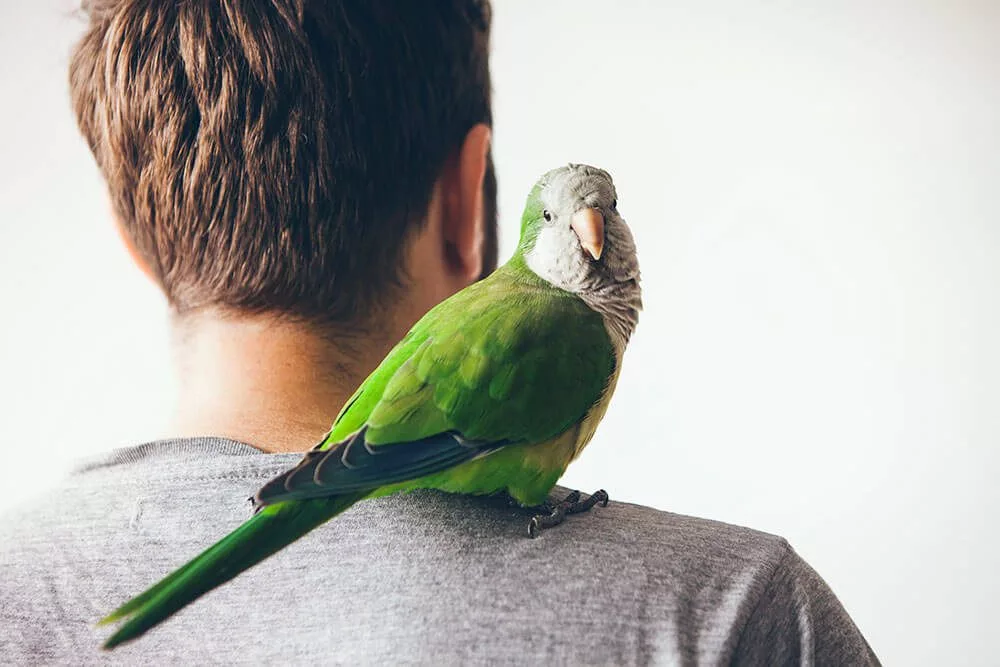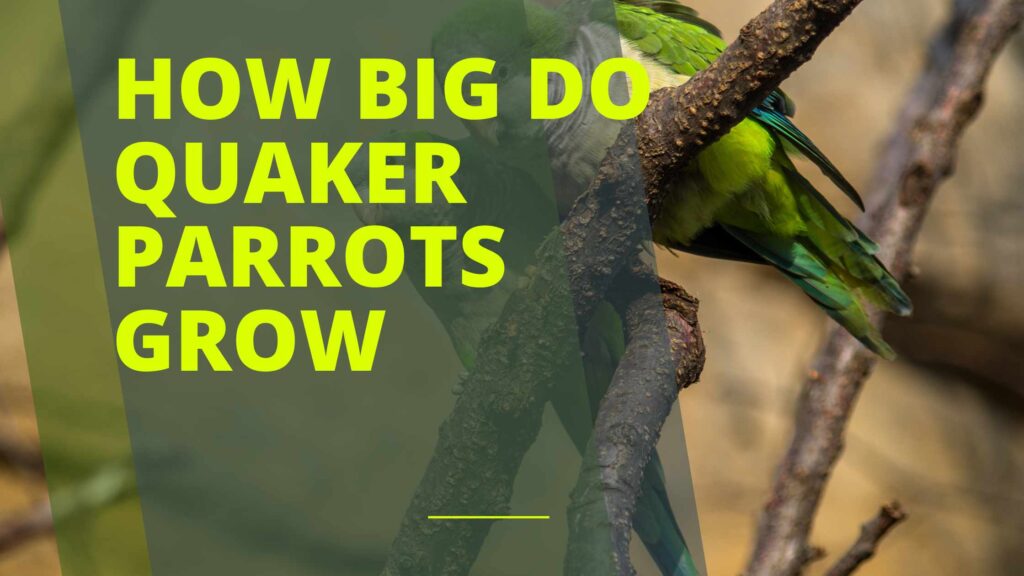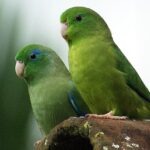Quaker parrots typically grow to a size of 11 to 12 inches in length. They weigh around 90 to 150 grams fully grown.
Quaker parrots, also known as monk parakeets, are popular pet birds known for their vibrant personalities and speaking abilities. Reaching a modest size that makes them suitable for most homes, these social birds possess a striking green plumage accented with grey on their chests and foreheads.
How Big Do Quaker Parrots Grow? They are native to South America but have adapted to different climates, even establishing colonies in urban areas in North America and Europe. With a robust build and a playful disposition, Quaker parrots require spacious cages and a variety of toys to satisfy their need for mental stimulation and exercise. Given proper care and attention, they can be delightful companions for up to 20 to 30 years, making them a long-term commitment for any bird enthusiast.
:strip_icc()/monk-parakeet-in-barcelona-1283029076-245274da359546a6a9a726bdb23a2064.jpg)
Credit: www.thesprucepets.com
The Quaker Parrot: A Brief Introduction
The Quaker Parrot, also known as the Monk Parakeet, stands out in the avian world. This small, vibrant bird brings a blend of charm and sociability to any home. Known for their playful nature and talking ability, Quaker Parrots offer companionship unlike any other pet bird. In terms of size, Quaker Parrots typically grow up to 11-12 inches in length, making them a perfect fit for parrot enthusiasts with limited space.
Native Habitat And Characteristics
Quaker Parrots originate from the temperate regions of Argentina and the surrounding countries in South America. Their adaptability allows them to thrive in various environments. Despite their South American roots, they’ve gained incredible popularity worldwide.
- Colorful plumage
- Intelligent and engaging
- Social birds, often forming large flocks
These birds showcase a predominantly green coloration with a gray abdomen, hints of blue on their tail feathers, and a scalloped-patterned neck. Their personalities are just as vibrant as their plumage.
Legal Considerations For Parrot Enthusiasts
Before bringing home a Quaker Parrot, it’s vital to understand the legal landscape. Some regions restrict or prohibit their ownership. This is due to their potential to form feral colonies that can impact local agriculture and native species.
| Region | Legal Status |
|---|---|
| California | Banned |
| Georgia | Ownership with permit |
| New Jersey | Legal to own |
| New York | Legal to own |
Always check local regulations before purchasing a Quaker Parrot. Regulations continuously evolve, so stay informed to ensure you remain compliant.
Size Matters: Expectations For Quaker Parrot Growth
Quaker parrots bring a bundle of joy to any home. Knowing how big Quaker parrots grow helps you prepare the perfect space. These birds, with their friendly demeanor, require ample room to flutter and play. Understanding their growth patterns ensures they live happily and healthily.
Typical Size Range
Quaker parrots typically grow between 11 and 12 inches (28 to 30 cm) in length, from beak to tail. They weigh around 90 to 120 grams. A fully grown Quaker has a wingspan of about 18 to 24 inches (48 to 60 cm). This size makes them a medium-sized parrot, ideal for most homes.
| Age | Length | Weight | Wingspan |
|---|---|---|---|
| Adult | 11-12 inches | 90-120 grams | 18-24 inches |
Factors Influencing Growth
Numerous factors play a role in the growth of Quaker parrots. Genetics determine their maximum size while nutrition significantly impacts their growth. A varied diet rich in fruits, vegetables, and seeds is crucial.
- Genetics
- Nutrition
- Environment
- Healthcare
Living conditions also affect their growth. A clean, spacious cage and regular exercise contribute to a healthy size. Lastly, regular check-ups with an avian vet ensure growth is on track. Preventing and treating any illness early helps maintain optimal growth.
From Hatchling To Adult: Growth Stages
Understanding the growth stages of a Quaker parrot is essential for any potential bird owner. These vibrant birds transition through several stages before reaching adulthood. In this section, we’ll explore these stages, taking a detailed look at what to expect as your feathered companion grows.
The First Feathers
After a Quaker parrot hatches, it experiences rapid growth. For the first few weeks, they are featherless and rely on their parents for warmth. The ‘first feathers’ phase marks an exciting developmental period, usually around the two to three week mark, when you’ll start to notice a soft layer of down. These pin feathers gradually unfurl into the parrot’s initial plumage, delicate and soft to the touch.
Juvenile Development
During the juvenile phase, which spans from the age of 3 months to full maturity, Quaker parrots learn to eat solid food and fly. This period is critical for their socialization skills. You’ll observe the growth of their colorful feather coat and their increased activity level. These young parrots need plenty of attention and playtime to ensure they develop a friendly and sociable demeanor.
Reaching Maturity
Quaker parrots typically reach full size between 1 and 2 years of age. This is when they reach maturity. Their plumage becomes more vibrant and their personality traits more pronounced. Mature Quaker parrots boast a fully-fledged coat and are known for their intelligence and ability to mimic speech. It’s important to provide ongoing mental stimulation and a healthy diet to maintain their well-being into adulthood.
| Age | Length (from head to tail) | Weight |
|---|---|---|
| Hatchling (0-2 weeks) | 2-3 inches | 10 grams |
| Juvenile (3-12 months) | Up to 10 inches | 90-120 grams |
| Adult (1-2 years) | 11-12 inches | 120-140 grams |
Quaker parrots grow to a size that is manageable for most homes, with an average adult length of 11 to 12 inches from head to tail and weighing between 120 and 140 grams.
Dietary Influence On Quaker Parrot Size
When it comes to Quaker parrots, size can be a concern for new owners. These lovable birds, when fully grown, usually span 11 to 12 inches in length. What they eat plays a massive role in reaching their ideal size. A balanced diet ensures not just a healthy growth, but also a vibrant, energetic life.
Essential Nutrients For Optimal Growth
A Quaker parrot’s diet should mirror what they eat in the wild. This means a blend of nutrients is vital for their growth. Let’s dive into the essentials:
- Proteins: They are crucial for muscle and feather development.
- Vitamins and Minerals: Necessary for strong beak and bone health.
- Carbohydrates: These provide energy for their daily activities.
- Fats: Important for healthy skin and feathers, but only in moderation.
Common Dietary Pitfalls
Poor diet can impede a Quaker’s growth. Take note of what not to do:
- Overfeeding: Can lead to obesity, affecting size and health.
- Seed-Only Diets: These lack necessary variety and nutrients.
- Human Food: Salty, sweet, or fatty foods are harmful to birds.
- Lack of Fresh Food: Fresh fruits and vegetables are essential for a complete diet.
The Impact Of Environment On Growth
Understanding the growth of Quaker parrots reveals a fascinating aspect of their care. Their growth can be hugely affected by their environment. Let’s explore how different factors play a role in their development.
Cage Size And Exercise
A spacious cage encourages active play and exercise. Quaker parrots thrive in environments where they can stretch their wings. Here are key points to consider for optimal growth related to cage size and exercise:
- Minimum Cage Size: At least 18x18x18 inches
- Bar Spacing: No more than 5/8 inch apart
- Exercise Time: Minimum of 20-30 minutes outside the cage daily
Toys and Perches should vary in size and texture. This variation promotes foot health and mental stimulation, both influential for growth.
Temperature And Humidity Considerations
Quaker parrots originate from temperate climates. Hence, their growth is optimal in controlled environments. Note the following temperature and humidity levels for Quaker parrots:
| Temperature | Humidity |
|---|---|
| Between 65-80°F (18-27°C) | Approximately 40-70% |
Sudden changes in temperature or humidity can stress these birds. Stress impacts immune function, which can, in turn, affect growth. Always aim for a stable environment in your parrot’s housing.

Credit: gregrichdvm.com
Health Matters: Recognizing Growth Problems
Quaker parrots, also known as Monk Parakeets, typically reach a charming size of 11 to 12 inches from head to tail. But, various health issues can affect their growth. As Quaker parents, understanding these issues is vital. It allows for a swift response, promoting a long, healthy life for these feathered companions. Let’s explore the signs of poor health and common ailments that hinder their growth.
Signs Of Poor Health
Spotting the early signs of health issues in Quaker parrots is crucial for preventing stunted growth. Look out for:
- Lack of appetite – Shows less interest in food.
- Weight loss or gain – Any sudden change is a red flag.
- Feathers – Watch for dull, ruffled, or plucked feathers.
- Behavior changes – Less singing or interaction.
- Discharges – From the eyes, nose, or beak.
- Waste – Changes in their droppings’ color or texture.
Common Ailments Affecting Growth
No Quaker parrot is immune to illness. Identifying and treating these common ailments is crucial:
| Ailment | Impact on Growth | Symptoms |
|---|---|---|
| Malnutrition | Limits overall development | Poor feather quality, weakness |
| Psittacosis | Affects multiple body systems | Respiratory issues, lethargy |
| Beak and Feather Disease | Impedes feather growth | Feather loss, beak deformities |
| Parasites | Fuels malabsorption | Itching, weight loss |
Regular vet checkups, a balanced diet, and clean living conditions are essential. Catching symptoms early on leads to better outcomes. Proper care means happy, healthy growth for your Quaker parrot.
The Role Of Genetics In Parrot Size
Exploring the role of genetics in parrot size reveals fascinating insights into how Quaker parrots grow. Similar to the diverse human family tree, genetic factors play a pivotal role in determining the size of these captivating birds. Let’s delve into the details.
Understanding Hereditary Factors
Quaker parrots inherit traits from their parents – just like you get your eye color. Genetics are the blueprint for growth, directly influencing a parrot’s stature. These factors include:
- Parental Genes: Mom and Dad’s sizes matter.
- DNA: It holds growth information.
- Breeding Lineage: Ancestors’ traits play a role.
It’s essential to recognize that genetic expression is more than just heredity. Environment and diet also shape growth, working alongside genetics.
Potential For Size Variation
Despite a general size range, expect variations among Quaker parrots. Here’s why:
- Mutations: These can create size differences, albeit rarely.
- Recessive Genes: Sometimes surprising traits emerge.
- Selective Breeding: Breeders might aim for larger or smaller birds.
A table illustrating the typical size range further highlights this variation:
| Condition | Size Range |
|---|---|
| Standard Size | 10-12 inches (25-30 cm) |
| Smaller Birds | < 10 inches (< 25 cm) |
| Larger Birds | > 12 inches (> 30 cm) |
In conclusion, genetics sets the basic framework for a Quaker parrot’s size. Individual birds might grow slightly larger or smaller due to different factors, including those beyond their genes.
:strip_icc()/monk-parakeet--myiopsitta-monachus--641818688-5b4c1a46c9e77c001aced3aa.jpg)
Credit: www.thesprucepets.com
Caring For Your Quaker Parrot
Quaker parrots, vibrant and intelligent birds, reach sizes up to 12 inches.
A happy Quaker is a healthy Quaker, and caring for these feathered friends is key.
Their care hinges on two core pillars: regular health checks and an environment that sparks their curiosity.
Regular Veterinary Checkups
It’s vital to schedule annual visits to an avian vet.
These checkups spot health problems early. Quaker parrots can hide illnesses well.
Early detection is crucial.
- Weight checks
- Feather and skin assessments
- Nail and beak inspections
Keep your bird’s health records organized.
Know your bird’s normal behaviors and appearance for quick problem spotting.
Creating A Stimulating Environment
Quakers thrive on play and learning.
A dynamic habitat keeps them sharp and joyful.
Change toys and puzzles regularly to keep them challenged.
| Toys | Benefits |
|---|---|
| Chewable wood | Beak health, diversion |
| Foraging puzzles | Mental stimulation |
| Mirrors or bells | Social engagement |
Not only toys, but daily interaction is crucial.
Spend time with your Quaker. Train them with simple tricks.
It strengthens your bond and keeps them engaged.
Conclusion
Understanding the growth of Quaker parrots helps owners provide suitable care. These delightful birds typically reach 11-12 inches as adults. Optimizing their environment and nutrition is paramount for their wellbeing. By doing so, your feathered friend is set to thrive, reflecting the joy these charming creatures bring into our lives.
Ryan Everhart is a passionate bird enthusiast and blogger, primarily writing on his website, Avian Whispers. His journey into the world of bird blogging began with a deep interest in parrots, a species that captivated his attention for their intelligence and social behavior. Over time, his content expanded to cover a broader range of bird species, offering insights into bird behavior, care, habitats, and conservation.
Ryan is dedicated to educating his audience, which includes both new bird owners and seasoned enthusiasts. His writing is filled with personal experiences, expert knowledge, and practical advice on bird care. Through Avian Whispers, he aims to foster a deeper appreciation for birds, emphasizing their role in nature and the joys of having them as pets.
Starting with articles focused on parrots, Ryan’s work now encompasses a diverse range of topics such as feeding, training, habitat enrichment, and bird health. His love for birds extends beyond parrots, diving into various avian species. His informative and heartfelt writing reflects his commitment to the well-being of birds and the desire to help others connect with these creatures.
As a growing voice in the bird blogging community, Ryan strives to provide a platform where bird lovers can learn, share experiences, and connect over a shared passion for avian life. His blogs are not only educational but also serve as a reminder of the importance of protecting and nurturing the bond between humans and birds.




